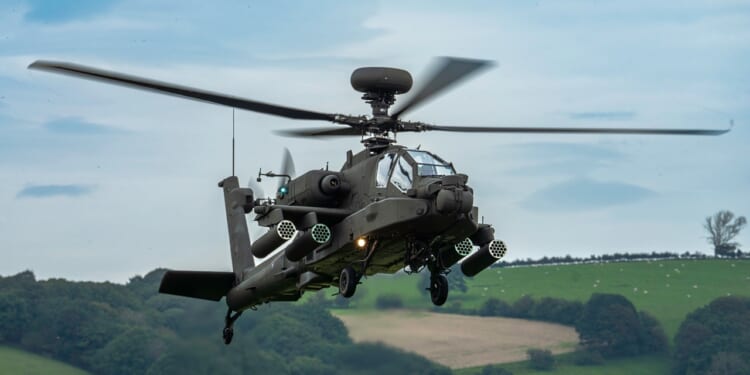There are no current plans for the Army to replace the Apache. Instead, modernization is the strategy—using periodic upgrades to keep the helicopter flying into the 2040s, and possibly beyond.
For 40 years, the AH-64 Apache has been an integral part of the US Army. Through budget cycles and modernization waves, through sweeping changes in military inventory and doctrine, the Apache has endured, still irreplaceable. And while the programs have been cancelled, or outsourced to drones, the Apache endures still—proving the viability of the initial design.
The AH-64 Apache’s Specifications
- Year Introduced: 1986 (initial variant) 2011 (AH-64E “Guardian,” newest variant)
- Number Built: ~2,400 total Apaches produced (all variants); ~800 AH-64Es built or converted worldwide
- Length: 58 ft 2 in (17.73 m)
- Rotor Diameter: 48 ft (14.63 m)
- Weight (MTOW): 23,000 lb (10,433 kg)
- Engines: Two General Electric T700-GE-701D turboshafts (~1,994 shp each)
- Top Speed: ~182 knots (~210 mph, 337 km/h)
- Range: ~260 nautical miles (~300 mi, 480 km); ~2.5 hours’ endurance (extendable with auxiliary tanks)
- Service Ceiling: ~21,000 ft (6,400 m)
- Armament:
- 1× M230 30mm chain gun
- Up to 16× AGM-114 Hellfire or AGM-179 JAGM missiles
- 70 mm (2.75 in) Hydra or APKWS guided rockets
- Optional Stinger/AIM-92 or Sidewinder AAMs (limited)
- Crew: 2 (pilot and co-pilot/gunner, in tandem seating)
The Apache Keeps Getting New Upgrades
The latest Apache variant, the AH-64E “Guardian,” carries various upgrades to ensure continued relevance. These include new composite rotor blades, more powerful engines, and an upgraded transmission that boosts lift in hot-and-high environments all address weaknesses in earlier variants. Inside the cockpit, the AH-64E boasts digital avionics, color displays, and data links that allow for control of unmanned companion aircraft, the MQ-1C Gray Eagle drone, which can be used for sensory information, or even a Hellfire missile strike. That manned-unmanned integration between the AH-64E and the MQ-1C drone is a harbinger of the future of warfare—and a large part of what keeps the Apache relevant in the 21st century.
Despite being nearly 40 years old, there are no current plans to replace the Apache. Instead, modernization is the strategy; the Army expects to keep the Apache in frontline service into the 2040s and possibly beyond, with incremental upgrades arriving every few years. The updates are expensive, of course. But upgrades are far cheaper and faster than developing a brand-new platform—a lesson the Army has learned the hard way. Efforts to field the Future Attack Reconnaissance Aircraft (FARA), a scout-attack hybrid replacement to the OH-58 Kiowa, were canceled in 2024 after billions were invested—a decision that helped to lock in the Apache for continued service.
Why Is the Apache Helicopter So Timeless?
The Apache has survived because no other platform can match the Apache’s firepower, protection, and battlefield awareness. The 30-mm M230 chain gun is brutally effective. The twin General Electric T700 engines and titanium-armored cockpit give the platform the ability to withstand intensive punishment and still return home, a degree of survivability that is invaluable. Perhaps most importantly, the Apache is fully woven into the Army’s existing doctrine, maintenance pipelines, and export networks. Replacing the Apache would mean tearing down an efficient, well-oiled system—one that still happens to be working.
None of which is to say that the Apache is perfect as it is. The next phase of upgrades will focus on improving networked warfare. Specifically, designers will aim to improve the Apache’s electronic warfare defenses, infrared countermeasures, and sensor fusion. Designers are also exploring lighter composite structures and hybrid-electric drive systems that could extend the platform’s range and reduce the heat signature.
In a generation or two, the Apache will almost certainly be replaced. That’s inevitable, as it is with all weapons systems (except the B-52 Stratofortress). But the replacement may not be conventional by today’s standards. The replacement may be optionally manned. Or it may simply be an armed drone—something consistent with the ongoing trend which is shifting away from manned platforms and toward unmanned platforms.
Right now, this is all just speculation, because the Apache is locked-in for the foreseeable future, with incremental upgrades ensuring the Apache remains relevant.
About the Author: Harrison Kass
Harrison Kass is a senior defense and national security writer at The National Interest. Kass is an attorney and former political candidate who joined the US Air Force as a pilot trainee before being medically discharged. He focuses on military strategy, aerospace, and global security affairs. He holds a JD from the University of Oregon and a master’s in Global Journalism and International Relations from NYU.
Image: Shutterstock / michael hassall.
















